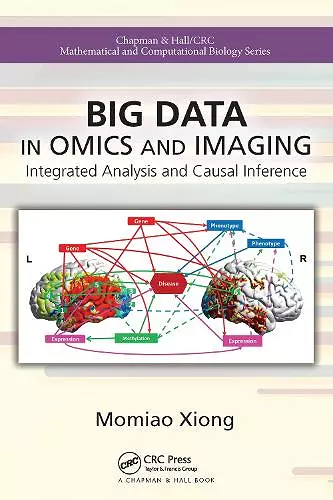Big Data in Omics and Imaging
Integrated Analysis and Causal Inference
Format:Paperback
Publisher:Taylor & Francis Ltd
Published:30th Jun '21
Currently unavailable, and unfortunately no date known when it will be back
This paperback is available in another edition too:
- Hardback£130.00(9780815387107)

Big Data in Omics and Imaging: Integrated Analysis and Causal Inference addresses the recent development of integrated genomic, epigenomic and imaging data analysis and causal inference in big data era. Despite significant progress in dissecting the genetic architecture of complex diseases by genome-wide association studies (GWAS), genome-wide expression studies (GWES), and epigenome-wide association studies (EWAS), the overall contribution of the new identified genetic variants is small and a large fraction of genetic variants is still hidden. Understanding the etiology and causal chain of mechanism underlying complex diseases remains elusive. It is time to bring big data, machine learning and causal revolution to developing a new generation of genetic analysis for shifting the current paradigm of genetic analysis from shallow association analysis to deep causal inference and from genetic analysis alone to integrated omics and imaging data analysis for unraveling the mechanism of complex diseases.
FEATURES
- Provides a natural extension and companion volume to Big Data in Omic and Imaging: Association Analysis, but can be read independently.
- Introduce causal inference theory to genomic, epigenomic and imaging data analysis
- Develop novel statistics for genome-wide causation studies and epigenome-wide causation studies.
- Bridge the gap between the traditional association analysis and modern causation analysis
- Use combinatorial optimization methods and various causal models as a general framework for inferring multilevel omic and image causal networks
- Present statistical methods and computational algorithms for searching causal paths from genetic variant to disease
- Develop causal machine learning methods integrating causal inference and machine learning
- Develop statistics for testing significant difference in directed edge, path, and graphs, and for assessing causal relationships between two networks
The book is designed for graduate students and researchers in genomics, epigenomics, medical image, bioinformatics, and data science. Topics covered are: mathematical formulation of causal inference, information geometry for causal inference, topology group and Haar measure, additive noise models, distance correlation, multivariate causal inference and causal networks, dynamic causal networks, multivariate and functional structural equation models, mixed structural equation models, causal inference with confounders, integer programming, deep learning and differential equations...
"I would like to recommend a new option in the library market, Big Data in Omics and Imaging: Integrated Analysis and Causal Inference, written by Momiao Xiong, a Professor of Biostatistics at the University of Texas Health Science Center in Houston. It is an extensive and comprehensive textbook on big data inbiomedical sciences. Indeed, its contents is very valuable, because it concerns the analysis of large-scale datasets, which now regularly occur in computational biology and medicine, in particular in ‘omics’ problems... The book introduces in detail the currently developed statistical methods and software for big genomic and epi-genomic, wearable biosensors, computing, and image data analysis. It covers important topics in this area, such as: genotype-phenotype network analysis, causal analysis and network biology, wearable computing and genetic analysis of function-valued traits, RNA-seq data analysis, methylation data analysis, imaging, and genomics... It was really interesting and fascinating to go through the pages of the book. It would hold a very valuable position on the home shelf-book or university library; I warmly recommend the book."
- Malgorzata Cwiklinska-Jurkowska, ISCB, December 2019
"In his book, Professor Xiong introduces, discusses, and implements a rich variety of statistical tools that can be used to study large-scale features obtained from the human brain and genome, map neural and genetic signatures to behavioral and disease outcomes, and make causal enquiries into their relationships. The scope of the book is comprehensive, the concepts deep, and technicalities oftentimes mathematically heavy...the book discusses statistical concepts and devices that readers may find useful in studying general problems in human neuroscience and human genetics."
- Oliver Y. Chén, Journal of the American Statistical Association, March 2020
"I would like to recommend a new option in the library market, Big Data in Omics and Imaging: Integrated Analysis and Causal Inference, written by Momiao Xiong, a Professor of Biostatistics at the University of Texas Health Science Center in Houston. It is an extensive and comprehensive textbook on big data inbiomedical sciences. Indeed, its contents is very valuable, because it concerns the analysis of large-scale datasets, which now regularly occur in computational biology and medicine, in particular in ‘omics’ problems... The book introduces in detail the currently developed statistical methods and software for big genomic and epi-genomic, wearable biosensors, computing, and image data analysis. It covers important topics in this area, such as: genotype-phenotype network analysis, causal analysis and network biology, wearable computing and genetic analysis of function-valued traits, RNA-seq data analysis, methylation data analysis, imaging, and genomics... It was really interesting and fascinating to go through the pages of the book. It would hold a very valuable position on the home shelf-book or university library; I warmly recommend the book."
- Malgorzata Cwiklinska-Jurkowska, ISCB, December 2019
"In his book, Professor Xiong introduces, discusses, and implements a rich variety of statistical tools that can be used to study large-scale features obtained from the human brain and genome, map neural and genetic signatures to behavioral and disease outcomes, and make causal enquiries into their relationships. The scope of the book is comprehensive, the concepts deep, and technicalities oftentimes mathematically heavy...the book discusses statistical concepts and devices that readers may find useful in studying general problems in human neuroscience and human genetics."
- Oliver Y. Chén, Journal of the American Statistical Association, March 2020
ISBN: 9781032095233
Dimensions: unknown
Weight: 1420g
766 pages